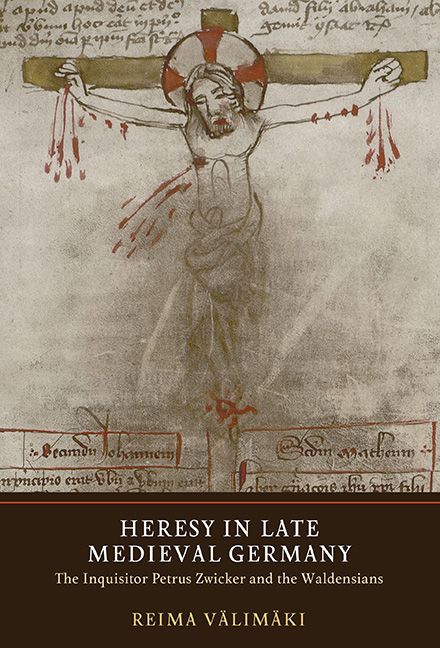Book contents
- Frontmatter
- Dedication
- Contents
- List of Illustrations
- Author's Note
- Acknowledgements
- List of Abbreviations
- Introduction
- 1 Petrus Zwicker and the Career of an Inquisitor at the Turn of the Fifteenth Century
- 2 The Inquisitor Writes
- 3 The Inquisitor's Practice and his Legacy
- 4 Communicating Faith
- 5 The Dissidents, the Clergy and the Church
- Epilogue: The Consolation of Inquisition
- Appendix 1 Manuscript Descriptions
- Appendix 2 Chapters and Titles of the Cum dormirent homines according to Jacob Gretser (1613/77)
- Appendix 3 The Circulation of the Processus Petri together with the Cum dormirent homines
- Appendix 4 Inquisitors' Manuals of St Florian and Linz
- Appendix 5 Collation of Formularies in St Florian, MS XI 234 and Würzburg, UB MS M. ch. f. 51
- Bibliography
- Index
- YORK MEDIEVAL PRESS: PUBLICATIONS
5 - The Dissidents, the Clergy and the Church
Published online by Cambridge University Press: 26 March 2019
- Frontmatter
- Dedication
- Contents
- List of Illustrations
- Author's Note
- Acknowledgements
- List of Abbreviations
- Introduction
- 1 Petrus Zwicker and the Career of an Inquisitor at the Turn of the Fifteenth Century
- 2 The Inquisitor Writes
- 3 The Inquisitor's Practice and his Legacy
- 4 Communicating Faith
- 5 The Dissidents, the Clergy and the Church
- Epilogue: The Consolation of Inquisition
- Appendix 1 Manuscript Descriptions
- Appendix 2 Chapters and Titles of the Cum dormirent homines according to Jacob Gretser (1613/77)
- Appendix 3 The Circulation of the Processus Petri together with the Cum dormirent homines
- Appendix 4 Inquisitors' Manuals of St Florian and Linz
- Appendix 5 Collation of Formularies in St Florian, MS XI 234 and Würzburg, UB MS M. ch. f. 51
- Bibliography
- Index
- YORK MEDIEVAL PRESS: PUBLICATIONS
Summary
Olim enim dum suborta essent scismata, cicius apponebantur remedia nedum per patres spirituales sed eciam principes seculares.
Once upon a time, when schisms would spring up, the remedies were more quickly applied, not only by spiritual fathers but also by secular princes.
Thomas Ebendorfer, Tractatus de schismatibus, after 1451.
Petrus Zwicker lived in times that were profoundly characterized by the Great Schism (1378–1417), a division that occurred in the papal election of 1378, leading to the election of two (and eventually three) rival popes in Rome and Avignon. In 1395, when Zwicker wrote the Cum dormirent homines, there were no foreseeable prospects of unification. Indeed, it seemed possible that the Church would remain permanently divided. In previous chapters I have suggested that certain features in Zwicker's writing, above all the endeavour to find a basis for the Church's doctrine and practices in the Scriptures alone, were a reaction to the uncertainty of the times. In this chapter I explore how Zwicker contributed to dealing with this uncertainty.
Even the fundamental principles of the Church and its hierarchy were undermined and questioned in the course of the Schism: the floor was open to both radical and revisionist opinions. People, laity and the clergy alike, without any connection to dissident groups, criticized practices they considered to be vain, novel additions or corruption in the Church. The translation of Zwicker's treatise by Ulrich von Pottenstein and the anti-Waldensian declarations in Johlin of Vodňany's sermons in particular are directed at such practices. There was a danger of slipping into Waldensian heresy when overtly criticizing the Church and the clergy. The refutation of heretical beliefs was thus more than an attack on an enemy of the late medieval Church. It was part of a process of keeping intact and in their right place the constituent elements of its wobbling spiritual geography, the dissidents, the good Catholic laypeople, the clergy and Mother Church herself.
Virgin Mary venerated and denigrated
The Virgin Mary had been honoured and loved by Christians from the earliest centuries of the Church, but in late medieval piety she acquired a status almost comparable to that of her son. From the late fourteenth century onwards, Mary takes a new position in the depictions of God's judgment.
- Type
- Chapter
- Information
- Heresy in Late Medieval GermanyThe Inquisitor Petrus Zwicker and the Waldensians, pp. 217 - 256Publisher: Boydell & BrewerPrint publication year: 2019

